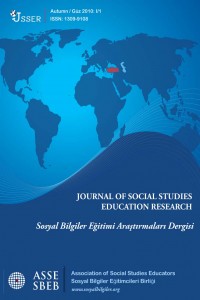Öz
Kaynakça
- Alkan, N. (2009). Tarihin çağlara ayrılmasında “üç”lü sistem ve “Avrupa merkezci” tarih kurgusu. Uluslararası Sosyal Araştırmalar Dergisi, 2( 9), 23-42.
- Aysevener, K., Barutca, E. M. (2003). Tarih felsefesi. İstanbul: Cem Yayınevi.
- Büyüköztürk, Ş. (2002). Sosyal bilimler için veri analizi el kitabı. (2. Baskı). Ankara: PegemA Yayınları.
- Bıçak, A. (2004). Tarih düşüncesi 1. Tarih düşüncesinin oluşumu. İstanbul: Dergah Yayınları.
- Çamuroğlu, R. (1999). Tarih, Heterodoksi ve Babailer. İstanbul: Om Yayınları.
- David, C., Lenoir, F. & De Tonnac, J. P. (2001). Zamanların sonu üstüne söyleşiler. İstanbul: Yapı Kredi Yayınları.
- Diem, Richard A. (1982). Developing chronological skills in a world history course. Social Education, 46(3): 191-194
- Fabian, J. (1999). Zaman ve öteki, antropoloji nesnesini nasıl oluşturur, (Çev. Selçuk Budak), Ankara: Bilim ve Sanat Yayınları.
- Garvey, B. (1975-1976). Time and history teaching. Teaching History, 4, 290-295.
- Hocaoğlu, D. (2002). ‘İlerleme’ üzerine bir tahlil denemesi. Köprü, Sayı, 78.
- Kramer, S. N. (1998). Tarih Sümerde başlar, (Çev. Muazzez İlmiye Çığ), Ankara: Türk Tarih Kurumu.
- Özlem, D. (1996). Tarih felsefesi. İstanbul: Anahtar Yayınları.
- Safran, M., Şimşek, A. (2009). Tarih yazımında bir sorun: Tarih ve zaman ilişkisi. Tarihin Peşinde (Uluslararası Tarih ve Sosyal Araştırmalar Dergisi), 1 (1), 9-26.
- Saxe, David Warren. (September/Octomber-1992). Resolving students confusion about ındefinite time expressions. The Social Studies, pg. 188-192.
- Saunders, R. M. (1996). National standards for United States history, The Social Studies. 87 ( 2), 63-67.
- Şimşek, A. (2006). İlköğretim öğrencilerinde tarihsel zaman kavramının gelişimi ve öğretimi. (Yayınlanmamış Doktora Tezi). Ankara: G.Ü. Eğitim Bilimleri Enstitüsü.
- Web 1. Basic Skills in Social Studies. http://www.savannah.chathome.k12.ga.us.03.10.2004 tarihinde alınmıştır.
- Web 2. National Center for History in the School, National History Standards, Chronological Thiking. http://nchs.ucla.edu/standards/chronologicalthiking5- 12.html. 17. 01. 2005 tarihinde alınmıştır.
- Web 3. Research, Writing and Ideas About Children’s Understanding of Time. http://www. uea.ac.uk. 22.10.2004 tarihinde alınmıştır.
Öz
Perception of historical time is shaped through the development of individuals. Individual's perception of time directly affects his/her view and interpretation of historical events. It is crucial to investigate how pre-service teachers perceive the historical time. Such an investigation becomes even more crucial for the pre-service primary teachers who teach history as a whole and with a holistic perspective.
In this study, a pre-service teacher's perception of historical time was investigated through the readings of a€œtime tablesa€ prepared by this teacher candidate. For this purpose, a cluster of 56 first year pre-service primary teachers from the University of Gaziantep was chosen for the study. They were asked to prepare time tables for the events that they thought were important. Following this, they were also applied a questionnaire with 11 open-ended items on the topic they chose for the time tables.
This study adopts a qualitative approach with a descriptive purpose. The data obtained from the questionnaires will be analyzed along with the time tables developed by the teacher candidates.
Acording to finds it's seen students have made time tables to different time forms oppossite to linner-metric time of Modernism. Its seen students have used lineer and cyclica and with ups and downs and intermediate-forms in their time tables. As the participants tended to express the historical processes in accord with their own understandings, they adopted different ways and languages in the prepared time tables.
Anahtar Kelimeler
Kaynakça
- Alkan, N. (2009). Tarihin çağlara ayrılmasında “üç”lü sistem ve “Avrupa merkezci” tarih kurgusu. Uluslararası Sosyal Araştırmalar Dergisi, 2( 9), 23-42.
- Aysevener, K., Barutca, E. M. (2003). Tarih felsefesi. İstanbul: Cem Yayınevi.
- Büyüköztürk, Ş. (2002). Sosyal bilimler için veri analizi el kitabı. (2. Baskı). Ankara: PegemA Yayınları.
- Bıçak, A. (2004). Tarih düşüncesi 1. Tarih düşüncesinin oluşumu. İstanbul: Dergah Yayınları.
- Çamuroğlu, R. (1999). Tarih, Heterodoksi ve Babailer. İstanbul: Om Yayınları.
- David, C., Lenoir, F. & De Tonnac, J. P. (2001). Zamanların sonu üstüne söyleşiler. İstanbul: Yapı Kredi Yayınları.
- Diem, Richard A. (1982). Developing chronological skills in a world history course. Social Education, 46(3): 191-194
- Fabian, J. (1999). Zaman ve öteki, antropoloji nesnesini nasıl oluşturur, (Çev. Selçuk Budak), Ankara: Bilim ve Sanat Yayınları.
- Garvey, B. (1975-1976). Time and history teaching. Teaching History, 4, 290-295.
- Hocaoğlu, D. (2002). ‘İlerleme’ üzerine bir tahlil denemesi. Köprü, Sayı, 78.
- Kramer, S. N. (1998). Tarih Sümerde başlar, (Çev. Muazzez İlmiye Çığ), Ankara: Türk Tarih Kurumu.
- Özlem, D. (1996). Tarih felsefesi. İstanbul: Anahtar Yayınları.
- Safran, M., Şimşek, A. (2009). Tarih yazımında bir sorun: Tarih ve zaman ilişkisi. Tarihin Peşinde (Uluslararası Tarih ve Sosyal Araştırmalar Dergisi), 1 (1), 9-26.
- Saxe, David Warren. (September/Octomber-1992). Resolving students confusion about ındefinite time expressions. The Social Studies, pg. 188-192.
- Saunders, R. M. (1996). National standards for United States history, The Social Studies. 87 ( 2), 63-67.
- Şimşek, A. (2006). İlköğretim öğrencilerinde tarihsel zaman kavramının gelişimi ve öğretimi. (Yayınlanmamış Doktora Tezi). Ankara: G.Ü. Eğitim Bilimleri Enstitüsü.
- Web 1. Basic Skills in Social Studies. http://www.savannah.chathome.k12.ga.us.03.10.2004 tarihinde alınmıştır.
- Web 2. National Center for History in the School, National History Standards, Chronological Thiking. http://nchs.ucla.edu/standards/chronologicalthiking5- 12.html. 17. 01. 2005 tarihinde alınmıştır.
- Web 3. Research, Writing and Ideas About Children’s Understanding of Time. http://www. uea.ac.uk. 22.10.2004 tarihinde alınmıştır.
Ayrıntılar
| Birincil Dil | İngilizce |
|---|---|
| Bölüm | History Education |
| Yazarlar | |
| Yayımlanma Tarihi | 30 Kasım 2010 |
| Yayımlandığı Sayı | Yıl 2010 Cilt: 1 Sayı: 1 |


